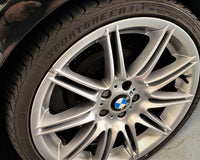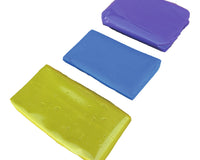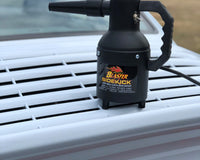We stock a great range of machine polishers to rectify most paint problems. However, it's important to understand what is wrong before you start polishing to your heart's content, especially if you’re a beginner.
Spending time researching the type of damage is the best way to ensure you can rectify the problem to the best of your ability. It will also help you to prevent any errors. . There a number of imperfections in the paintwork that will simply polish out with the correct tools. Others won’t!
Below are a few of the common paint problems you will find, with an idea of how to fix them, you will also see a picture above showing a few examples as a guide.
Oxidation
Over time, harmful UV rays make paintwork look dull. blacks turn to grey, and reds to pink, etc. Oxidation used to be a real issue for older paints – modern paint colours and modern technology are getting way better, meaning clear coats have now been made to give greater protection to the paint underneath. Oxidation can be removed using an abrasive polish working by hand or ideally with a machine polisher.
Swirl marks
They are almost always incurred during the washing and drying process or picked up whilst driving. Swirls can look like cobwebs on the paintwork. The more cobwebs, the more light is refracted. Swirl marks play a major factor in the lack of gloss in the paintwork. Most swirl marks can usually be removed by hand with a suitable abrasive polish, however again a machine polisher will give better results much quicker.
Small scratches
These are usually seen in the clear coat and are caused in most cases by dirt and grit being rubbed over the surface due to poor washing techniques and sometimes drying. Small scratches that are not deeper than a nail will normally polish out. If there are only a few scratches using an off the shelf scratch remover will work well. However, if you have a larger number then a machine polisher is more likely to remove them.
Deeper Scratches
Deeper scratches usually go through the clear coat and penetrate the paint or even go as deep as the primer layer. Deeper scratches can be identified by slowly running a fingernail across them, if your nail catches in the groove it’s a deeper scratch. These types of scratches cannot usually be machine polished out to give a completely fine finish. However, they can be reduced by rounding off the edges of the groove, thereby the light refracting off the edges reducing the unsightly impact. This may be a more cost-effective solution than a re-spray for some customers.
Holograms
Also known as buffer trails, are caused by poor machine polishing techniques, even on brand new cars! These leave a blurry swirling effect on paintwork causing it to look dull and greasy. Holograms are usually easy to remove using the correct combination of machine polisher, pad and compound. Attempts to remove buffer trails through hand polishing is unlikely to work. Stone chips These can seriously ruin a great car, caused by stone impact with the bodywork. These usually appear around the front end of the car as smallish rounded spots and look greyish white in colour, caused by the primer layer showing through. Stone chips go deep to the primer and actually are the result of several layers of clear coat and paint having been dug out of the bodywork. These will not machine polish out. Specialist products are required to fill in stone chips to reduce their appearance.
Bird Poo
Birds usually poo on flat surfaces unless in flight. On hot days it makes matters worse as the suns heat the paintwork. It then expands around the edges of the bird poo and as it cools contracts. This combined with the uric acid content in the poo can cause severe etching on the surface of the clear coat. Remove it as quick as you can to avoid damage, and get a good wax, sealant or ceramic coating on your car to minimise the effect it the worst occurs.
Acid Rain
Acid rain is caused by a combination of sulphur dioxide & nitrogen oxide, produced as a from carbon fuel combustion, volcanic eruptions or even lightning, combined with water to produce acid rain. Carbon dioxide in the atmosphere combines with water to form carbonic acid. These all wash out of the atmosphere with rain and react with clear coats to leave irregularly shaped patches, visible most clearly in direct sunlight and on darker coloured vehicles. There are varying intensities of acid rain etching and whilst some will polish out with the right tools, if the rain has a particularly strong acidic composition or has been combined with some other factor, such as ash, there are occasions when this type of blemish will not polish out fully.
Again the best way to guard against this type of damage is to ensure your vehicle has been protected with a good quality wax, sealant or ideally a ceramic coating.
Water spots
Calcium Carbonate from rain or impurities in domestic water can leave a deposit on the paintwork if the vehicle is not properly dried. As with bird poo, as paintwork expands and contracts around the watermarks, the edges become etched into the clear coat and usually require machine polishing to remove.
The best solution is either filter your domestic supply, or alternately to use a touchless drying method or a high-quality drying cloth to ensure all surfaces of your car are thoroughly dry. We stock a great range of products to help solve these and other automotive issues.
With a little bit of knowledge and right products, you can ensure your paintwork stays brighter for longer, without unsightly marks and blemishes damaging your car, motorcycle or other vehicle.




